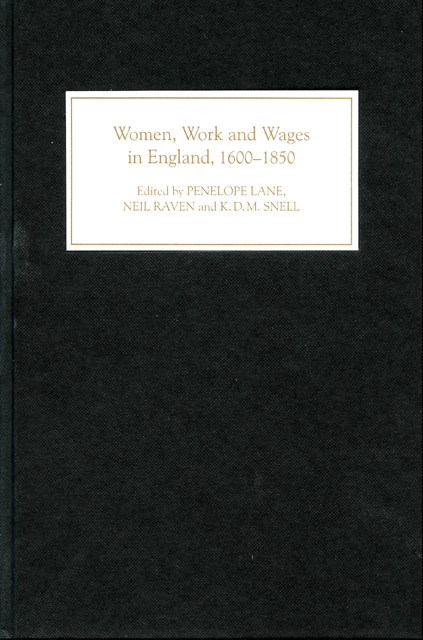Book contents
- Frontmatter
- Contents
- Illustrations
- Notes on Contributors
- Acknowledgements
- Introduction
- 1 ‘Waste’ Children? Pauper Apprenticeship Under the Elizabethan Poor Laws, c. 1598–1697
- 2 Gender at Sea: Women and the East India Company in Seventeenth-Century London
- 3 Sickles and Scythes Revisited: Harvest Work, Wages and Symbolic Meanings
- 4 A Customary or Market Wage? Women and Work in the East Midlands, c. 1700–1840
- 5 ‘Meer Pennies for My Baskitt Will be Enough’: Women, Work and Welfare, 1770–1830
- 6 Caring for the Sick Poor: Poor Law Nurses in Bedfordshire, c. 1770–1834
- 7 ‘A ‘Humbler, Industrious Class of Female’: Women’s Employment and Industry in the Small Towns of Southern England, c. 1790–1840
- 8 A Diminishing Force? Reassessing the Employment of Female Day Labourers in English Agriculture, c. 1790–1850
- Bibliography
- Index
8 - A Diminishing Force? Reassessing the Employment of Female Day Labourers in English Agriculture, c. 1790–1850
Published online by Cambridge University Press: 21 March 2023
- Frontmatter
- Contents
- Illustrations
- Notes on Contributors
- Acknowledgements
- Introduction
- 1 ‘Waste’ Children? Pauper Apprenticeship Under the Elizabethan Poor Laws, c. 1598–1697
- 2 Gender at Sea: Women and the East India Company in Seventeenth-Century London
- 3 Sickles and Scythes Revisited: Harvest Work, Wages and Symbolic Meanings
- 4 A Customary or Market Wage? Women and Work in the East Midlands, c. 1700–1840
- 5 ‘Meer Pennies for My Baskitt Will be Enough’: Women, Work and Welfare, 1770–1830
- 6 Caring for the Sick Poor: Poor Law Nurses in Bedfordshire, c. 1770–1834
- 7 ‘A ‘Humbler, Industrious Class of Female’: Women’s Employment and Industry in the Small Towns of Southern England, c. 1790–1840
- 8 A Diminishing Force? Reassessing the Employment of Female Day Labourers in English Agriculture, c. 1790–1850
- Bibliography
- Index
Summary
The years between the beginning of the Napoleonic Wars and the onset of mid-Victorian prosperity were ones of fluctuating fortunes for the agricultural labour force in England. Wartime contingency gave way after 1815 to increasing casualisation and immiseration for large sections of the rural workforce. A surfeit of labour following demobilisation encouraged farmers to dismiss their annually hired servants and look to the benefits of enlargement, enclosure and arable production. These shifts were regionally distinct, being felt most severely by labourers in the southern English counties. The consequences of such changes also had specific ramifications for rural female labourers, although the nature and extent of these is not fully understood by historians. Did wartime male conscription necessitate farmers to employ women in large numbers only to dismiss them after 1815? Did women find it increasingly difficult to procure remunerative farm work over the early decades of the nineteenth century? Were female work patterns and wages dictated solely by economic forces or did ideological and customary factors also impinge on women’s workforce participation? These issues will be explored here through an examination of a number of farm labour and wage accounts from southern England between 1790 and 1850. The focus of the chapter will be female labourers – women who were hired mostly by the day, and paid a daily rate for their work. The regional and seasonal nature of female day labour in agriculture will be investigated, alongside trends in women’s earnings.
Perspectives on women’s work in agriculture
Any discussion of women’s employment in the late eighteenth- and early nineteenth-century agricultural labour force owes a debt to Ivy Pinchbeck’s meticulous survey of contemporary printed sources, published in her 1930 book Women Workers and the Industrial Revolution, 1750–1850. Her analysis of the female day labour force in agriculture identifies two peaks in the level of women’s work. The first, which began in the late eighteenth century and continued throughout the course of the French Wars, was linked to changes in agrarian production (new crops and methods of cultivation) and shortages of male labour (wartime conscription). However, Pinchbeck believed that evidence for this ‘gradual increase’ in women’s work was incomplete, with ‘no statistics available to show the proportion of women employed or the amount of work they were able to obtain’.
- Type
- Chapter
- Information
- Women, Work and Wages in England, 1600-1850 , pp. 190 - 211Publisher: Boydell & BrewerPrint publication year: 2004
- 1
- Cited by

